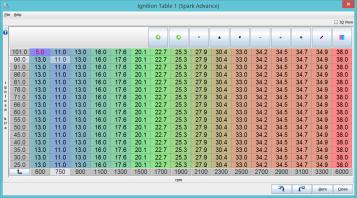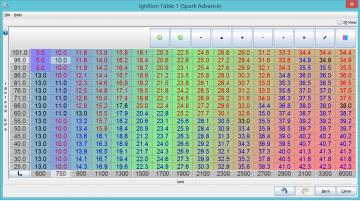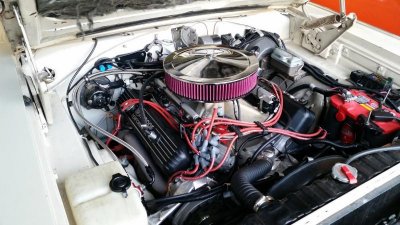I was finally able to get the MS3 computer to control the ignition timing. There were a few hiccups, but now the computer triggers an MSD box just like a set of points would. The computer controls advance entirely. There is still a distributor sending spark to each cylinder, but the MS3 does the timing. I had to swap in a locked out distributor and carefully set the rotor phasing, but once it got dialed in, things were good.
The computer has a table that sets advance based on manifold vacuum and RPM, just like the distributor would. However, it gives you infinitely variable curves. I started by making very basic table that advanced with RPM, like the mechanical part of a distributor. In the pictures below, the Y-axis is manifold pressure. WOT would be near the top, idle is about the "60" row, and cruise is near the bottom. I settled on this table:
There is no vacuum advance on this table. All I tried to do was get a consistent ping and misfire free acceleration through the gears at medium throttle. My motor seems to like close to 10 degrees near idle, but a pretty fast advance rate after that. Beyond that, I really don't know what I'm doing here.
Here is a table generated by a tool online that makes some assumptions based on cylinder head design, bore diameter, idle speed and vacuum, etc. I'm not sure what's going on here, so if anyone has theories, I'm happy to hear them.
What I can say is the motor didn't like this table very much. Cruising, idle, etc., were all pretty good. Acceleration was not. Minor misfires and surging happened a lot, as well as really lean readings on the O2 sensor. I think it's a reasonable start but I'll need to adjust it to match the first table along the path that would describe normal driving. I hope to do that and smooth out this table and try it soon.
The beauty is these changes don't even require opening the hood. You can do it with the car running. To get the first table, I started with 10 initial and 32 at 2500 RPM. Then I bumped columns a degree either way until things smoothed out, then interpolated the rest of the table. In half an hour. Without opening the hood.
Response is so much better too. It's pretty impressive. I do hope to do individual coils at some point, but it's not going to be soon.


















